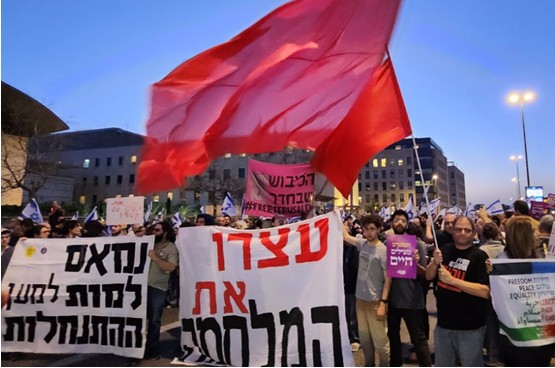The second day on Monday, March 1, of a planned four-day demonstration outside the Israeli parliament saw thousands of people once again gather on Jerusalem’s Kaplan Street, just below the Knesset and other government buildings to demand the resignation of far-right Prime Minister Benjamin Netanyahu and his government, as well as the return of Israeli hostages in Gaza.

“Stop the war”, Hadash and Communist Party of Israel activists in Sunday’s massive protest against far-right government, March 31, 2024 (Photo: Zo Haderech)
Monday’s rally was smaller than Sunday’s initial protest, which saw tens of thousands rally against the country’s current leadership, in the largest such demonstration since the start of the war in Gaza. Organizers claimed more than 100,000 people had taken part, while media outlets reported turnout in several tens of thousands. The major demonstration in front of the Knesset and government offices on Sunday night was a replica of the mass struggles against the judicial overhaul last year.
Protesters in Jerusalem blocked a nearby highway, Begin Road lit bonfires on its lanes and the Chords Bridge at entrance of Jerusalem. The demonstrators, who are holding protests in Jerusalem through Wednesday, set up hundreds of tents in front of the Knesset and the adjacent Gan Sacher.
On last Saturday, March 30, thousands of people took part in a march that ended with a rally in the town of Deir Hanna in the Galilee, to commemorate the 48th anniversary of Land Day – an annual event commemorating protests that broke out on March 30, 1976 against government land seizures in which six Arabs were killed by Israeli security forces.
Israeli police allowed the march to take place on condition that no Palestinian flags will be flown, claiming it could ‘lead to public disorder.’ Organizers decided to abide by the order and write slogans against the war in the colors of the Palestinian flag instead, however Palestinians flags flowed during the rally. All Hadash lawmakers and Communist Party of Israel leading activists took part, as every year, in the march. MK Yosef Atawneh wrote: “We will stand firm and continue to fight against the government of killing and destruction until the war stops.” Other events were held in several places throughout the country, including in Sakhnin, Kfar Qassem and Al-Arakib in the Negev.
On March 11, 1976, Israel’s government, then headed by Yitzhak Rabin, published a plan to expropriate some 20,000 dunams (2,000 hectares or 4,942 acres) of land stretching between the neighboring Arab cities of Sakhnin and Arabeh in the Galilee, 6,300 dunams of which were privately owned by Arab residents of the area. In response to this plan, following a decision by the Central Committee of the Communist Party of Israel, local Arab leaders called for a day of general strikes and mass protests against the confiscation of lands to be held on March 30. The mayor of Nazareth, the communist Tawfiq Ziad, was among the local Arab leaders who made such a call.
To frustrate the protest of the Arab community, the governmental declared a curfew to be imposed on the villages of Sakhnin, Arabeh, Deir Hanna, Tu’ran, Tamra and Kabul, effective from 17:00 on March 29, 1976, the day before the general strike. Rabin’s government declared all demonstrations illegal and threatened to dismiss from their jobs any “agitators,” such as schoolteachers, who encouraged their students to participate. However, the threats were not effective, and many teachers led their pupils out of the classrooms to join the general strike and marches that took place throughout the Arab towns in Israel and which were violently suppressed by the military and police.
On March 30, 1976, thousands of Arab-Palestinians in the northern Galilee region demonstrated against the seizure of Arab land, prompting Israeli troops to use lethal force, killing six Arab-Palestinians. In the wake of the first Land Day, a year later, in 1977, the Communist Party of Israel and other progressive forces founded the Democratic Front for Peace and Equality (Hadash – Jabha). For the last 48 years, Palestinians have been commemorating the deadly events by holding marches in the occupied West Bank, the Gaza Strip and Arab villages in Israel.
Related: https://maki.org.il/en/?p=31701


